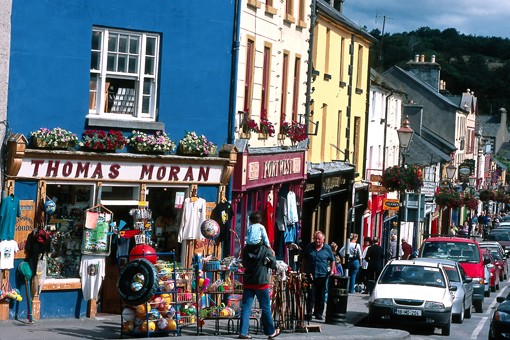
Holidays in Connacht take visitors to the Gaelic-speaking west of Ireland. Misty mountain roads wind down to the sea and a coast dotted with remote islands. Find your Connacht hotel in one of the brightly colored towns brimming with live Irish music.
Get your bearings
Facing the Atlantic Ocean, Connacht (or Connaught) is one of four ancient Irish provinces. It was once a kingdom ruled by King Conor and has preserved its natural, untamed beauty.
Galway City buzzes with life, while nearby
Gaeltacht villages and islands, where Irish is still spoken, reflect traditional Irish culture. Northwards lie the mountains of the
Connemara National Park and beyond is
County Mayo with its craggy coastline, sacred Croagh Patrick mountain and lively coastal town
Westport.
County Sligo is known as Yeats Country, because the Irish poet grew up there. The quiet inland counties of
Leitrim and
Roscommon are on the
Shannon basin.
Galway
Galway City is one of the most popular places for Connacht holidays. It is a small bohemian city with shops selling
Claddagh rings for lovers and Celtic crafts. Enjoy the Galway Races or hop on a boat to the
Aran Islands, including Inis Mór where you can visit the 1st-century Dún Eoghanachta fort. You’re likely to hear Gaelic spoken on the islands and in villages west of Galway City from Berna to Cheathrú Rua. Some visitors book Connacht hotels here to practice their Irish and explore the glens of the
Connemara National Park.
Mayo
Brightly painted
Westport fills up with visitors seeking traditional Irish music in its dozens of pubs. Many make the arduous journey to the summit of Croagh Patrick mountain, where St Patrick preached. Across the road is the moving National Famine Memorial, a ghostly ship filled with the skeletons of starved famine victims. Off the coast,
Achill Island, a quiet retreat for winding down, is popular for cycling and surfing. Inland,
Knock Shrine draws thousands of pilgrims for prayer and contemplation, while Cong, where
The Quiet Man was filmed, is favoured by film buffs
Sligo
WB Yeats grew up in Sligo and said it greatly influenced his life. His comments have prompted generations of visitors to see its beauty for themselves. Its 13th- century Dominican friary, with ancient monastic high altar, cloisters and tombs, attracts history and culture lovers. South of Sligo, the
Carrowmore Megalithic Cemetery is a burial site dating back to the 4th century BC. The north of the county is dominated by the dramatically steep Benbulben limestone ridge, associated with Celtic legends of the warrior Diarmiud. Today it’s popular with climbers and botanists.
Leitrim and Roscommon
Leitrim and Roscommon are set amid a watery landscape of loughs (lakes) and the River Shannon basin. Anglers come for the coarse fishing, while others take the waterbus to Leitrim’s
Swan Island Lakeside Centre on Lough Gill for horse riding or kayaking.
Roscommon’s Stokestown Park House offers a moving insight into the Great Irish Famine of the 1840s and includes letters written by tenants living on the estate.
 Holidays in Connacht take visitors to the Gaelic-speaking west of Ireland. Misty mountain roads wind down to the sea and a coast dotted with remote islands. Find your Connacht hotel in one of the brightly colored towns brimming with live Irish music.
Holidays in Connacht take visitors to the Gaelic-speaking west of Ireland. Misty mountain roads wind down to the sea and a coast dotted with remote islands. Find your Connacht hotel in one of the brightly colored towns brimming with live Irish music.